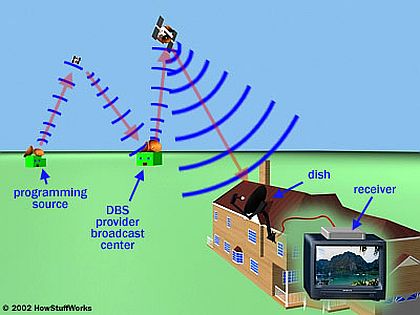High-definition televisions have come from the realm of early-adopting home theater enthusiasts into the average consumer market. Early HDTV sets cost thousands of dollars, but today stores sell some models for less than $300. However, buying an HDTV is just the first step in accessing HD programming. Consumers still need an HD media source to take full advantage of their new television sets.
High-definition satellite service — or satellite HD — is one service option for HDTV. By subscribing to a satellite HD service and purchasing the appropriate equipment, HDTV owners can watch a wide variety of programs with crisp, clear visuals and immersive surround sound.
Satellite HD service works almost the same way as standard satellite television. The satellite service provider receives programming from various sources, then beams a compressed digital signal containing its entire channel lineup through a satellite dish to a satellite in geosynchronous orbit. This means that the satellite maintains its position relative to the Earth, moving at the same speed as the Earth’s rotation. If we couldn’t put satellites into geosynchronous orbit, satellite television wouldn’t exist. That’s because the customer needs to align his or her own satellite dish so that it’s aimed at the correct satellite overhead. If the satellite moved in relation to the Earth, the customer would have to continuously adjust the aim of his or her satellite dish, and sometimes the satellite would move to the other side of the Earth and no amount of adjustment would result in a signal.
The orbiting satellite acts as both a receiver and a transmitter. It receives the feed of channels from the service provider, then transmits that information back in a beam toward the Earth. The customer dish acts as an antenna. The dish picks up the signals and sends them to a receiver set-top box (STB). For a more detailed analysis on how satellite television works, read our article on “How Satellite TV Works.”
Older satellite system receivers convert the signal from a digitally compressed format like MPEG-2 into an analog signal. But HDTV sets can interpret high-definition signals — that’s where satellite HD comes in. Satellite HD service uses the same principles as regular satellite television, but with different encoding methods. With the right STB, you can decode and view this high-definition signal.
In the next section, we’ll learn how satellite service providers encode signals. We’ll also discuss the equipment you’ll need to receive those signals and decode them so that you can watch HDTV.
Satellite HD Signals and Equipment
Uncompressed video signals require a lot of bandwidth — so much, in fact, that satellites can’t handle receiving and transmitting that much information at the same time. That’s why satellite service providers compress video signals, especially when they’re high-definition video. They use a compression system standardized by the Moving Picture Experts Group (MPEG).
There are a few different MPEG encoding standards. You’re probably familiar with MP3 files, which are audio files that use the MPEG-1 standard. Until recently, satellite systems compressed video using the MPEG-2 standard, which reduces video size by a factor of about 55:1. Today, DISH network and DIRECTV, the two major satellite service providers in the United States, use the MPEG-4 compression standard. This format is more efficient than MPEG-2 and is better suited for complex, fast-moving images like those in sporting events and action movies.
Before the switch to MPEG-4 compression, satellite service providers could only offer a few HD channels due to the demand on system bandwidth. As cable companies began to develop HD packages, satellite systems had to look for new ways to deliver HD signals to customers in order to stay ahead of the competition. Both DIRECTV and DISH Network have upgraded to the MPEG-4 format, which allows both companies to provide more HD channels by streaming them more efficiently. Unfortunately, this upgrade also means that customers have to upgrade their equipment in order to view that programming.
Satellite companies had designed customer dishes and set-top boxes to receive and convert signals broadcast in the MPEG-2 format. The MPEG-4 format wasn’t at all like MPEG-2, so customers’ existing equipment couldn’t receive and decode the new signals. These customers had a choice to make: stick with the old service and keep their old equipment, or pay money to upgrade and access more HD content. While satellite service providers are currently leaving the choice up to individual customers, in the future all providers will use the MPEG-4 format. At that point, old equipment will become useless.
Apart from the different encoding techniques, satellite HD receivers are similar to standard set-top boxes. The video signal arrives at the customer’s dish and travels through a cable to the receiver. The receiver has three jobs:
- Decrypt the signal. In order to thwart would-be signal thieves — people who use hacked dishes and receivers to steal satellite service — satellite service providers scramble television signals using encryption codes. The companies sell or lease receivers that include a chip designed to decrypt incoming signals. This way, only customers with the right equipment will be able to view incoming signals.
- Decompress the signal. Compression formats like MPEG-4 make it possible to transport an HD signal from a provider to a customer, but televisions can’t interpret compressed signals. The receiver must convert the signal from MPEG-4 to its uncompressed state.
- Feed the signal to the television. Once the receiver decrypts and decompresses the signal, it sends it on to the customer’s HDTV.
For more Detail: How Satellite HD Works

